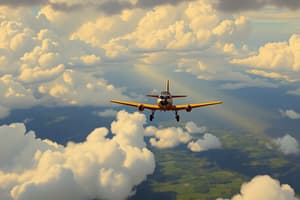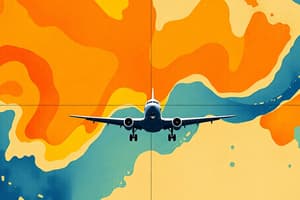Podcast
Questions and Answers
Identify the airspace over Sprague Airport.
Identify the airspace over Sprague Airport.
Class G airspace - surface up to but not including 1,200 feet AGL, class E airspace - 1,200 ft AGL up to but not including 18,000 feet MSL.
When flying over Arrowwood National Wildlife Refuge, a pilot should fly no lower than?
When flying over Arrowwood National Wildlife Refuge, a pilot should fly no lower than?
2,000 feet AGL.
What is the night visibility requirement for flight in Class G airspace at 3,000 feet AGL, but below 10,000 feet MSL?
What is the night visibility requirement for flight in Class G airspace at 3,000 feet AGL, but below 10,000 feet MSL?
3 miles.
What is the minimum cloud clearance and visibility requirement for day VFR flight in Class G airspace at 700 feet AGL?
What is the minimum cloud clearance and visibility requirement for day VFR flight in Class G airspace at 700 feet AGL?
Under what condition may an aircraft operate from a satellite airport within Class C airspace?
Under what condition may an aircraft operate from a satellite airport within Class C airspace?
What are the vertical limits of Class E airspace designated as a Federal Airway over Magee Airport?
What are the vertical limits of Class E airspace designated as a Federal Airway over Magee Airport?
What is the height of the floor of the Class E airspace above Georgetown Airport?
What is the height of the floor of the Class E airspace above Georgetown Airport?
What is the vertical limit of Class C airspace above the primary airport?
What is the vertical limit of Class C airspace above the primary airport?
The lateral dimensions of Class D airspace are based on?
The lateral dimensions of Class D airspace are based on?
What must all operations within Class C airspace be conducted in?
What must all operations within Class C airspace be conducted in?
What hazards to aircraft may exist in areas, such as Devils Lake East MOA?
What hazards to aircraft may exist in areas, such as Devils Lake East MOA?
What is the floor of the Savannah Class C airspace at the shelf area (outer circle)?
What is the floor of the Savannah Class C airspace at the shelf area (outer circle)?
What hazards to aircraft may exist in restricted areas such as R-5302B?
What hazards to aircraft may exist in restricted areas such as R-5302B?
What is the day visibility requirement for flight in Class G airspace above 1,200 feet AGL and below 10,000 feet MSL?
What is the day visibility requirement for flight in Class G airspace above 1,200 feet AGL and below 10,000 feet MSL?
What minimum radio equipment is required to land and takeoff at Norfolk International?
What minimum radio equipment is required to land and takeoff at Norfolk International?
What is the floor of the Class E airspace over Commerce?
What is the floor of the Class E airspace over Commerce?
What are the visibility and cloud clearance requirements to operate VFR during daylight hours over Sandpoint Airport at 1,200 feet AGL?
What are the visibility and cloud clearance requirements to operate VFR during daylight hours over Sandpoint Airport at 1,200 feet AGL?
What type of military flight operations should a pilot expect along IR 644?
What type of military flight operations should a pilot expect along IR 644?
What is the normal radius of the outer area of Class C airspace?
What is the normal radius of the outer area of Class C airspace?
Which initial action should a pilot take prior to entering Class C airspace?
Which initial action should a pilot take prior to entering Class C airspace?
The town of Findlay is located in what class airspace?
The town of Findlay is located in what class airspace?
What action should a pilot take when operating under VFR in a Military Operations Area (MOA)?
What action should a pilot take when operating under VFR in a Military Operations Area (MOA)?
What does TRSA Service in the terminal radar program provide?
What does TRSA Service in the terminal radar program provide?
Flashcards are hidden until you start studying
Study Notes
Airspace Classification and Requirements
- Class G Airspace: Extends from the surface up to but not including 1,200 feet AGL; transitions to Class E airspace at 1,200 feet AGL up to but not including 18,000 feet MSL.
- Minimum Altitude for Wildlife Areas: Pilots must fly no lower than 2,000 feet AGL over areas such as Arrowwood National Wildlife Refuge.
- Night Visibility in Class G: Minimum visibility of 3 miles is required for flight at 3,000 feet AGL and below 10,000 feet MSL.
- Day VFR Visibility in Class G: Minimum visibility of 1 mile and remain clear of clouds when flying at 700 feet AGL.
Class C and D Airspace Regulations
- Operations in Class C Airspace: Pilots must contact ATC as soon as practicable after taking off from a satellite airport within Class C airspace.
- Vertical Limits of Class E Airspace: Defined area over Magee Airport ranges from 1,200 feet AGL to 17,999 feet MSL.
- Floor of Class E Airspace: Above Georgetown Airport, Class E airspace starts at 3,823 feet MSL.
- Vertical Limit of Class C Airspace: Typically extends to 4,000 feet AGL above the primary airport.
Equipment and Compliance in Airspace
- Transponder Requirements in Class C: All operations must occur in aircraft equipped with a 4096-code transponder with Mode C.
- Radio Requirements for Norfolk International: Mode C transponder and two-way radio are mandatory for takeoff and landing.
Safety and Hazard Awareness
- Military Operations Areas (MOA): Hazards like acrobatic or abrupt maneuvers are common; exercise caution.
- Visibility and Cloud Clearance in Class C: To operate VFR at 1,200 feet AGL over Sandpoint Airport, pilots need 3 miles visibility and specific cloud clearance measurements.
- Restricted Areas Hazards: Operations may encounter unusual hazards, such as aerial gunnery or guided missiles, especially in restricted areas like R-5302B.
Additional Airspace Information
- Outer Area Radius of Class C: Typically has a radius of 20 nautical miles from the primary airport.
- Initial Actions for Class C Entry: Pilots should contact approach control on the designated frequency before entering Class C airspace.
- Findlay's Airspace Classification: The town is situated in surface area Class E airspace.
- VFR in Military Operations Areas: Pilots must exercise extreme caution when military activities are taking place.
- TRSA Service: Provides sequencing and separation for participating VFR aircraft within terminal radar services.
Studying That Suits You
Use AI to generate personalized quizzes and flashcards to suit your learning preferences.




